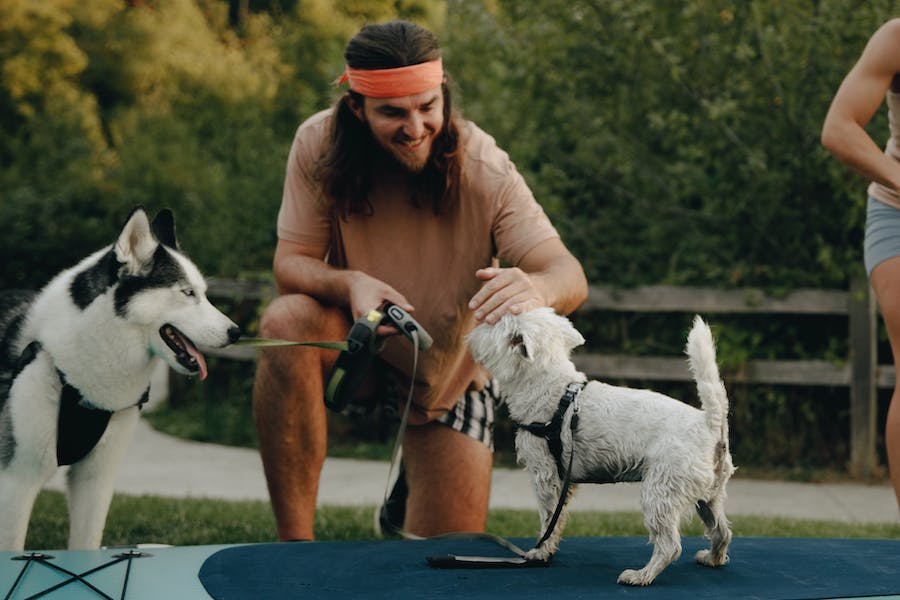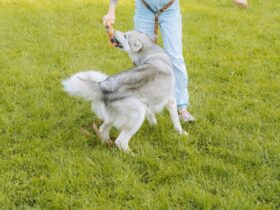Huskies, renowned for their striking appearance and vibrant energy, are a breed that captivates many dog lovers. Originating from Siberia, where they were bred as sled dogs, these intelligent and independent canines possess remarkable vitality. The exercise needs of Huskies, stemming from their athletic lineage, are crucial to their care. This article delves into the importance of understanding and meeting these needs, outlining how the right amount of physical activity is essential for their physical and mental health. By exploring the exercise requirements of Huskies, we aim to help owners ensure a fulfilling and joyful life for their furry companions.
Do huskies need a lot of exercise?
Huskies do require a substantial amount of exercise. Bred originally as sled dogs, Huskies are naturally high-energy and endurance animals. They thrive on physical activity, which is essential not just for their physical health but also for their mental well-being. A lack of adequate exercise can lead to various behavioral issues such as excessive barking, digging, and other destructive behavior. A Husky should have at least one to two hours of vigorous exercise daily, including running, hiking, and playing fetch. This exercise regimen helps to keep them healthy, happy, and well-balanced.
The Importance Of Exercise For Huskies
The importance of exercise for Huskies cannot be overstated. These energetic and spirited dogs, originally bred for pulling sleds in harsh Arctic conditions, possess a natural propensity for activity and stamina. This inherent trait necessitates a consistent and rigorous exercise regimen for several key reasons:
Regular exercise is crucial for keeping Huskies in optimal health. It helps in preventing obesity, maintaining healthy joint function, and ensuring good cardiovascular health. Huskies have a high metabolism and a robust build, which benefit significantly from regular physical activity.
Huskies are not just physically active but also intellectually curious and require mental stimulation. Exercise provides an outlet for their energy and helps prevent boredom, which can otherwise lead to destructive behaviors such as digging, chewing, or excessive howling. Activities like agility training, puzzle games, and extended play sessions enhance their mental enrichment.
Exercise sessions are an excellent opportunity for Huskies and their owners to strengthen their bond. Engaging in activities such as running, hiking, or playing fetch enhances trust and understanding between the dog and its owner. This bonding is essential for a breed known for its independent nature.
Regular walks and outdoor activities allow Huskies to socialize with other dogs and humans, which is vital for their overall social development. Socialization helps in reducing anxiety and aggression, making them well-adjusted and friendly.
Regular, albeit less strenuous, exercise is vital for aging Huskies to keep them agile and delay the onset of age-related issues. It helps maintain muscle tone and flexibility, essential for their overall mobility and quality of life in their senior years.
Given their history as sled dogs, Huskies have an inherent need to work and run. Exercise channels this energy productively, fulfilling their instinctual desires to roam and explore.
Physical Characteristics And Energy Levels Of Huskies
Huskies are a distinctive breed known for their unique physical characteristics and high energy levels, which play a crucial role in their exercise requirements:
Stature and Build: Huskies are medium-sized dogs, typically weighing 35 to 60 pounds, with a well-proportioned, muscular build. This sturdy physique enables them to engage in vigorous physical activities, making them well-suited for endurance exercises.
Coat and Skin: They possess a dense double coat, with a soft undercoat and a longer topcoat, designed to protect them from harsh Arctic temperatures. While this coat is advantageous in cold climates, owners must avoid overheating during exercise in warmer environments.
Eyes and Vision: Huskies are renowned for their striking eyes, which can be blue, brown, or heterochromatic (each eye a different color). Their sharp vision complements their physical prowess, aiding them in navigation and activity.
Energy Levels: Huskies are incredibly energetic and require significant physical activity. Their energy is physical and mental; they are curious and playful, demanding physical and mental stimulation.
Endurance and Stamina: Originally bred for pulling sleds over long distances, Huskies have remarkable endurance. They can sustain prolonged periods of physical activity without tiring easily, making them ideal companions for long-distance running or hiking.
Agility and Speed: Despite their endurance-oriented breeding, Huskies are also agile and can move quickly. This agility makes them excellent at activities that require sudden changes in direction, like agility courses.
Respiratory and Cardiovascular Efficiency: Huskies have a robust respiratory and cardiovascular system optimized for cold climates and endurance work. This trait allows them to exercise intensely without getting winded quickly.
Metabolism: They have a high metabolism, which fuels their energy levels and requires them to replenish their energy stores regularly. This high metabolism makes proper nutrition as important as exercise.
Paw Structure: Their paws are uniquely adapted to snowy environments, providing traction and insulation. While this is beneficial in cold weather, care should be taken on hot surfaces.
Tail and Body Language: The Husky’s tail indicates energy and mood. Curling over their back often signifies alertness and readiness for activity, an important cue for owners to recognize their need for exercise.
Recommended Exercise Regimen For Huskies
For Huskies, a breed known for their high energy and endurance, a well-structured exercise regimen is crucial for their health and happiness. Here’s a detailed guide to an adequate exercise routine for Huskies:
Daily Exercise Requirement:
Huskies require at least one to two hours of vigorous exercise daily. This can be divided into several daily sessions to keep them stimulated and prevent boredom.
Running and Jogging:
Huskies excel at and enjoy running due to their sled-pulling heritage. Jogging or running with your Husky is an excellent way to meet their exercise needs. Ensure they are on a leash unless in a secure, fenced area.
Hiking and Trail Walking:
These activities are great for Huskies, providing both physical exercise and mental stimulation. The changing scenery and smells on trails keep their minds engaged.
Fetch and Frisbee:
Games like fetch and Frisbee are perfect for Huskies, combining running with the excitement of chasing and retrieving. These games also help in improving their agility and coordination.
Agility Training:
This training benefits Huskies by exercising their body and stimulating their mind. It involves guiding them through obstacle courses, which can be physical and mental challenges.
Swimming:
If your Husky enjoys water, swimming can be an excellent exercise, especially in warmer weather. It’s a low-impact activity that’s great for their joints and muscles.
Playtime with Other Dogs:
Social play with other dogs can be an excellent way for Huskies to expend energy. Ensure that play sessions are supervised, especially with smaller dogs, due to the Husky’s high energy levels.
Sled Pulling/Dog Sports:
In winter climates, Huskies can participate in sled pulling, a natural and enjoyable activity. Similar dog sports like carting or bikejoring can be alternatives in non-snowy areas.
Mental Exercise:
Along with physical activities, Huskies need mental stimulation. Puzzle toys, hide-and-seek with treats, and training sessions that challenge them mentally are vital.
Adjustments for Age and Health:
Puppies, seniors, and Huskies with health issues require adjusted exercise regimens. Puppies should have shorter, less intense sessions, while older Huskies might benefit from gentle walks and swim sessions.
Consistency and Routine:
Huskies thrive on routine. Consistent exercise schedules help them understand what to expect each day, which can reduce anxiety and destructive behavior.
Bottom Line
Their high energy and endurance require a comprehensive exercise regimen that includes at least one to two hours of physical activity daily. This should mix vigorous exercises like running, hiking, agility training, and mental stimulation through interactive games and puzzles. Tailoring the routine to their age and health and considering weather conditions is crucial. Consistent and varied exercise is essential for their physical and mental well-being, preventing behavioral issues and ensuring a happy, balanced life for these energetic and intelligent dogs.
FAQ’s
Q. What happens if Huskies don’t get exercise?
A. If Huskies don’t get enough exercise, they can develop behavioral and health issues. Lack of physical activity often leads to excess energy, resulting in destructive behaviors like chewing and digging. Insufficient exercise can cause obesity, joint problems, and decreased mental well-being. Regular, vigorous exercise is crucial for a Husky’s physical and mental health.
Q. Is a 30-minute walk enough for a Husky?
There needs to be more than a 30-minute walk for a Husky. These high-energy dogs, bred for endurance, generally require much more physical activity to stay healthy and happy. Huskies should have at least one to two hours of vigorous exercise each day, including activities beyond walking, such as running, playing, or agility training. Short walks can be part of their exercise regimen, but they should not be the sole form of activity.
Q. Is it difficult to keep a Husky?
A. Keeping a Husky can be challenging due to their high energy, need for regular exercise, and independent nature. They require consistent training, socialization, and engagement. Additionally, their thick coat needs regular grooming. However, with dedication and proper care, Huskies can be rewarding companions.







Leave a Reply